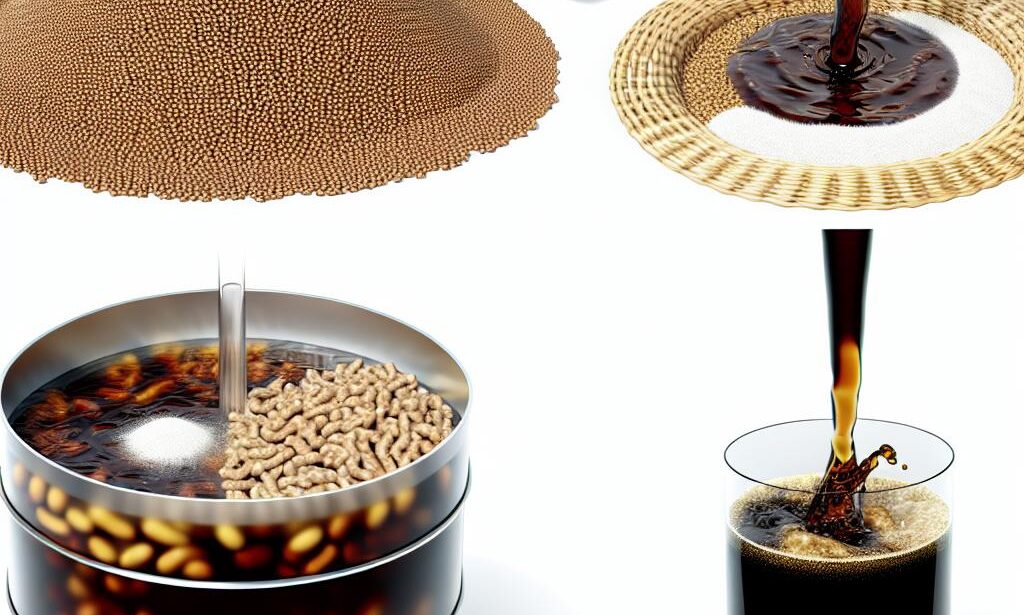Soy sauce is a staple condiment in many Asian cuisines, known for its rich umami flavor and versatility in enhancing dishes. While store-bought soy sauce is readily available, making your own at home can be a rewarding and flavorful experience. In this article, we will explore the process of creating homemade soy sauce through fermentation, and how this traditional method can elevate the taste of your dishes.
Table of Contents
- Introduction to Homemade Soy Sauce
- The Fermentation Process: Key to Flavor Development
- Ingredients and Equipment Needed for Making Soy Sauce at Home
- Tips for Achieving the Perfect Umami Taste
- Q&A
- Concluding Remarks
Introduction to Homemade Soy Sauce
Homemade soy sauce is a versatile condiment that can elevate the flavor of any dish. By fermenting soybeans and wheat with salt and water, you can create a rich and savory sauce that is perfect for marinades, stir-fries, and dipping sauces. Making your own soy sauce allows you to control the ingredients and customize the flavor to suit your taste preferences.
During the fermentation process, beneficial bacteria and yeast break down the proteins and carbohydrates in the soybeans and wheat, creating complex flavors and aromas. The longer the fermentation period, the deeper and more intense the flavor of the soy sauce. Homemade soy sauce is a labor of love that requires patience and attention to detail, but the end result is a delicious and unique condiment that is worth the effort.

The Fermentation Process: Key to Flavor Development
Fermentation is a crucial process in the creation of homemade soy sauce, as it is the key to developing the rich and complex flavors that we all know and love. Through the fermentation process, soybeans are transformed into a savory and umami-packed condiment that can elevate any dish.
During fermentation, the soybeans are combined with salt and a specific type of mold called koji. This mixture is left to ferment for several months to allow the flavors to develop and intensify. The enzymes produced during fermentation break down the proteins and carbohydrates in the soybeans, creating a depth of flavor that is unmatched by store-bought soy sauce.
By understanding and mastering the fermentation process, you can create your own homemade soy sauce that is tailored to your taste preferences. Experiment with different fermentation times and ingredients to create a soy sauce that is truly unique and delicious.

Ingredients and Equipment Needed for Making Soy Sauce at Home
For those looking to elevate their culinary skills and experiment with homemade condiments, making soy sauce at home can be a rewarding and flavorful experience. To create your own batch of soy sauce, you will need a few key ingredients and equipment to kickstart the fermentation process.
Ingredients:
- Soybeans
- Wheat
- Salt
- Water
- Koji spores (Aspergillus oryzae)
Equipment Needed:
- Fermentation vessel
- Cheesecloth or muslin cloth
- Glass jars or bottles for storage
- Measuring cups and spoons
- Strainer

Tips for Achieving the Perfect Umami Taste
One key tip for achieving the perfect umami taste in your dishes is to use homemade soy sauce. By fermenting soybeans and wheat together, you can create a rich and flavorful sauce that enhances the overall taste of your food. The fermentation process allows for the development of complex flavors, including the savory umami taste that is so sought after in Asian cuisine.
Another tip is to use high-quality ingredients when making your soy sauce. Opt for organic soybeans and non-GMO wheat to ensure the best possible flavor. Additionally, consider adding other umami-rich ingredients such as dried shiitake mushrooms or kombu seaweed to further enhance the depth of flavor in your homemade soy sauce.
Q&A
Q: What is soy sauce and how is it traditionally made?
A: Soy sauce is a popular condiment made from fermented soybeans, wheat, salt, and water. Traditionally, soy sauce is made through a fermentation process that can take several months to develop its rich flavor.
Q: Why would someone want to make homemade soy sauce?
A: Making homemade soy sauce allows for customization of flavors and ingredients, as well as the satisfaction of creating a traditional condiment from scratch.
Q: What ingredients are needed to make homemade soy sauce?
A: To make homemade soy sauce, you will need soybeans, wheat, salt, water, and a starter culture such as koji mold or brine from a previous batch of soy sauce.
Q: How long does it take to ferment homemade soy sauce?
A: The fermentation process for homemade soy sauce can take anywhere from a few months to a year, depending on the desired flavor profile and fermentation conditions.
Q: What are some tips for enhancing the flavor of homemade soy sauce through fermentation?
A: To enhance the flavor of homemade soy sauce, you can experiment with different types of soybeans, wheat, and fermentation times. Adding additional ingredients such as garlic, ginger, or dried mushrooms can also add depth and complexity to the final product.
Q: How should homemade soy sauce be stored?
A: Homemade soy sauce should be stored in a cool, dark place in a sealed container to prevent contamination and maintain its flavor. It can also be refrigerated for longer shelf life.
Concluding Remarks
In conclusion, making homemade soy sauce through fermentation is a rewarding and flavorful process that allows you to customize the taste to your liking. By following the steps outlined in this article, you can create a delicious and unique soy sauce that will enhance the flavor of your dishes. Experiment with different ingredients and fermentation times to find the perfect balance of umami and depth of flavor. So why not give it a try and elevate your culinary creations with your very own homemade soy sauce

